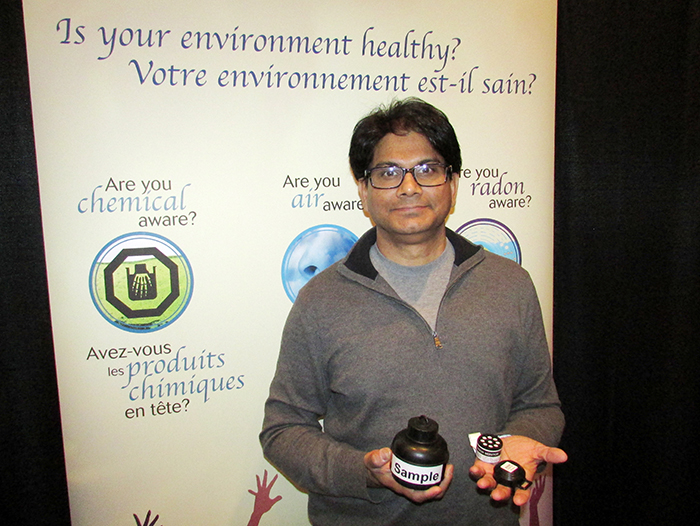
Chatham-Kent is one of only two municipalities in Ontario where one in five homes have a higher concentration of radon gas than recommended, according to a 2011 cross-Canada survey.
To help educate people in the community about the dangers of radon gas, Health Canada had experts available at the Chatham-Kent Home and Garden Show this past weekend with information and advice.
Mainul Husain, a radiation specialist with Health Canada’s Environmental Health Program, was at the home show and spoke to The Voice about the issue.
“Radon is a natural gas but it is not an ordinary gas – it is radioactive and it comes from soil,” Husain explained. “Soil in Canada has trace amounts of uranium, and over time, uranium degrades and gives off radon gas, and this gas, through the pores and cracks in soil, comes up and goes into the environment.”
The gas, he noted, in the open air doesn’t pose a problem as it is a low concentration, referred to as background radon that is naturally occurring.
“The health issue that comes with this radon gas is when it enters a house, because a house is enclosed, and most houses have cracks or openings in the foundation,” he noted. “Radon gas gets into the house and causes a health issue. One issue we know of is lung cancer. More than 3,000 die every year in Canada of lung cancer because of this gas, and that is why Health Canada is trying to raise awareness.”
He said Health Canada is more interested in the Chatham area because it has one of the highest concentrations of radon in Ontario. More than 20 per cent of the homes tested are above the guideline of 200 Bq (becquerels) per cubed metre. That is the maximum allowable limit in a home and Husain said any reading above that concentration needs to be fixed.
“We did a study in 2011 that showed more than 20 per cent of the homes in Chatham are above the guideline and that is one of the reasons we are here, trying to raise awareness and let people know they are living every day with a silent killer in their home,” Husain said.
The effects of radon gas are long-term health issues and how long it takes for illness to occur depends on individuals and their general health and age. He said children and seniors are more vulnerable. For example, children in some homes play hard and breathe faster in basements and their bodies are still growing. If they are exposed at an early age, it can lead to health issues later in life.
“We are asking every family, every new parent, to take care of your kids and test your home,” Husain added.
Testing your home for radon gas on your own is easy and will save money, according to Husain. Just visit takeactiononradon.ca/test on the Health Canada sponsored website and from there you can buy a certified test kit for between $30-$60. Leave the test kit off the ground on a table or counter, or Husain said you can hang it from the ceiling by a string for at least three months, preferably in the fall or winter months to get an accurate reading.
If you start testing in the spring or summer, he suggests going for seven months but not more than one year.
The kit is then sent to a lab for analysis, with the address in the original test package.
Husain added it is important that if you go elsewhere for your test, make sure the person you hire is a professional certified by the Canadian National Radon Proficiency Program (C-NRPP) and has proof of that certification. He also said the testing should be included in the original fee, and certified professionals will not ask you to then pay the testing cost as well.
“The price you pay up front to buy the device should cover the lab fee. They should not be charging anything twice. If they charge or ask twice, people should not buy that device,” Husain cautioned. “Our strong recommendation before they buy a test kit is to ask the seller if they need to pay the lab as well. Certified device sellers should not be charging twice.”
Finding out you have a higher concentration of radon gas in your home doesn’t mean you have to pack up your family and move, Husain said. There are remedial actions that can be taken to make sure your home is safe.
“People can install an active ventilation system – active soil depressurization. It’s a stack of PVC pipe with a fan in the middle and the fan runs 24/7. It creates an exhaust underneath the foundation and exhausts the gas outside the home before it enters into a home. It’s a very effective system. At Health Canada, we did our study and know that these systems are 95 to 99 per cent effective,” Husain noted.
He also recommended sealing cracks and holes in their foundation and also sealing your sump pump will help.
Husain said it doesn’t matter if the home is old or new as long as there are not a lot of cracks or holes.
One study done in Calgary, he said, showed that newer homes can sometimes be worse because they are more airtight.
Health Canada also has radon education for health-care providers so they can counsel their patients on the effects of radon on their health and answer any questions. The website for information and resources is radon.machealth.ca. Husain said he can also come and speak to groups about the issue.
For more information on radon gas, visit healthcanada.gc.ca/radon.





